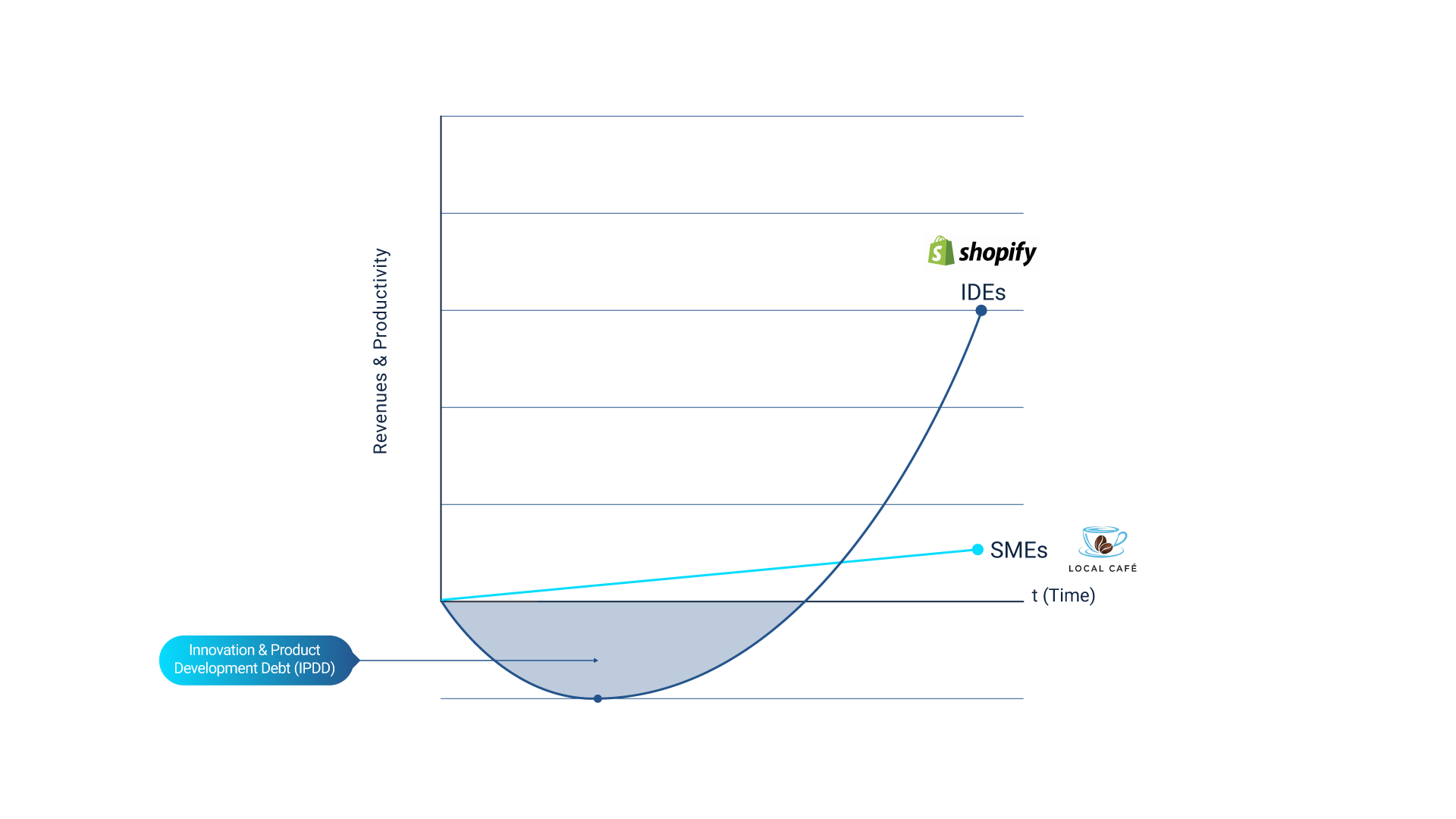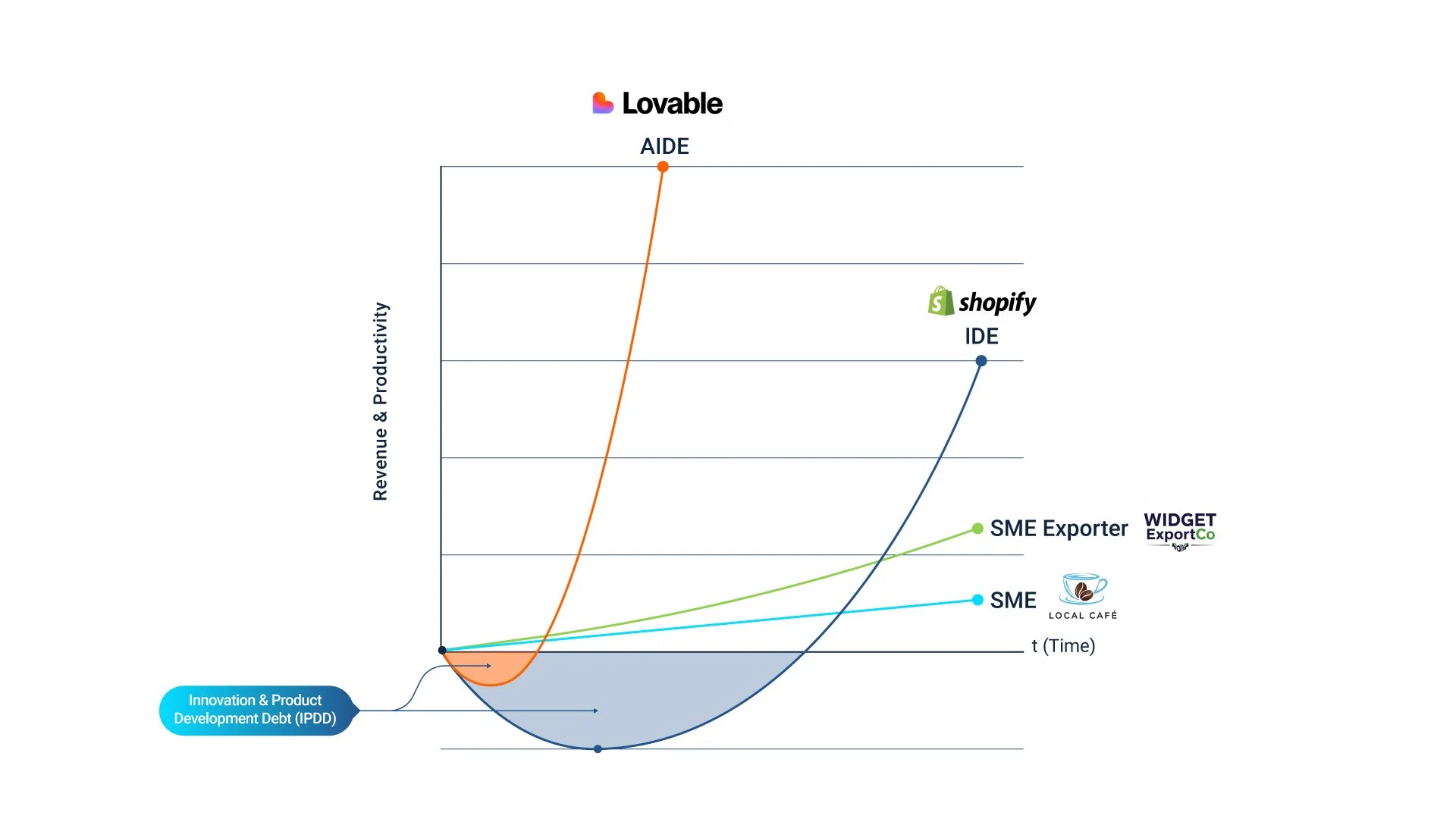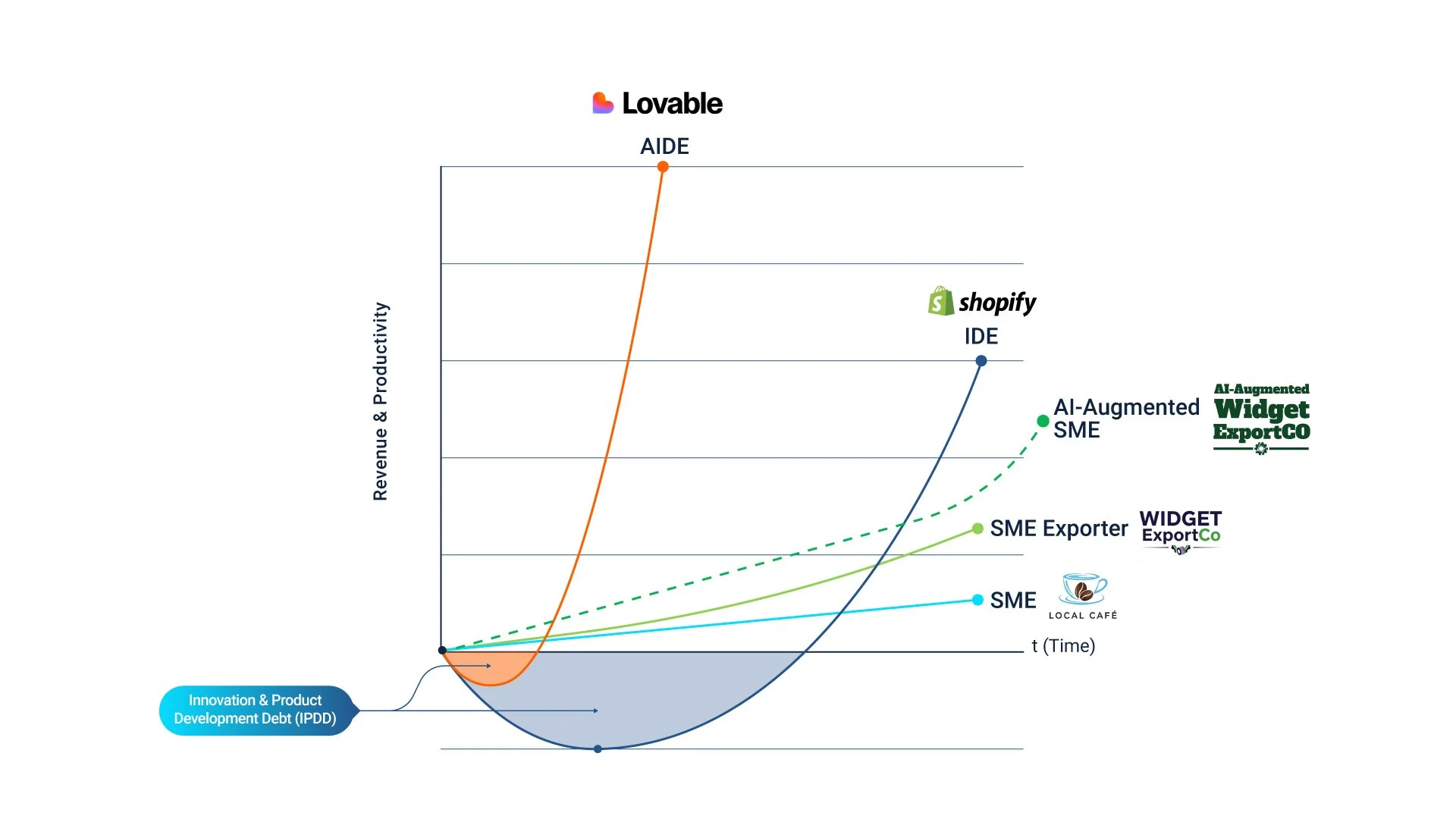Empowering SME Exporters with AI: Bending the Vector of Growth & Societal Impact
By Paul Cheek, Senior Advisor, Entrepreneurship & AI, Martin Trust Center for MIT Entrepreneurship and Jeff Larsen, Assistant Vice-President, Innovation and Entrepreneurship, Dalhousie University
Why it Matters
SME exporters stand at a pivotal crossroads, poised to leap from steady incremental growth to explosive global impact by harnessing AI’s transformative power—traditionally the domain of startups and innovation giants. Unlocking this potential means deploying AI-driven tools that streamline everything from market forecasting to export compliance to new product features, enabling lean teams to punch far above their weight and reshape economic landscapes beyond major tech hubs. Discover how practical AI adoption can bend the vector of economic growth and societal progress, turning small exporters into exponential impact engines that democratize and redefine global trade.
Empowering SME Exporters with AI: Bending the Vector of Growth & Societal Impact
Imagine transforming a modest local business into a global exporter capable of exponential growth and societal impact…
Traditionally, this transformative potential has been reserved for Innovation-Driven Enterprises (IDEs)—firms such as Shopify that are designed around disruptive technologies with substantial capital and long innovation cycles. Small and Medium-sized Enterprises (SMEs) such as your local coffee shop, are typically deeply rooted in their communities and operating with lean resources, typically cannot harness these opportunities. But SME exporters, a distinct subset of SMEs specifically engaged in selling products and services internationally, possess untapped potential. How can these SME exporters, characterized by incremental innovation and modest scale, leverage artificial intelligence (AI) to shift their growth trajectories from linear to exponential? Interestingly, Shopify started as an online snowboard shop before transitioning to the IDE we know it as today.
Entrepreneurship is a vehicle for economic growth and societal progress, and AI can empower SME exporters to achieve unparalleled global impact.
Understanding SME Exporters—Challenges and Potential
SME exporters typically operate with small teams, limited resources, and a targeted focus on international markets. Unlike general SMEs that primarily serve local or regional markets, SME exporters must navigate additional complexities such as international regulations, cross-border logistics, and market-specific consumer behaviors. While some SME exporters turn into international juggernauts, many have modest growth which is constrained by:
Limited access to capital
Incremental innovation due to resource constraints
Slow scaling prospects
Challenges related to international compliance and cultural differences
However, SME exporters hold distinct advantages—specialized knowledge, niche market products, and established reputations—that can serve as foundations for international growth.
Introduction to AI-Driven Enterprises (AIDEs) and What They Teach Us
AI-Driven Enterprises (AIDEs) represent a new category of startups, showcasing exponential growth through AI integration at every operational level. These enterprises:
Drastically reduce innovation product development debt (IPDD)
Allow rapid iteration and market entry
Achieve high revenue with minimal headcount
Per Bill Aulet, “innovation and product development debt (IPDD)” is the gap or “valley of death” between an idea and a market-ready product. During this period, revenue is minimal or nonexistent, so IDEs rely heavily on risk capital (angel investors, venture capital, non-dilutive grant funding, etc.) and/or sweat equity to fund R&D and initial go-to-market efforts.
For instance, Lovable.dev rapidly scaled its revenue to $17M ARR in just three months with a lean team of 15 employees by integrating AI extensively into its product development and operations. This ultra-lean approach demonstrates the transformative potential AI holds, a potential traditionally inaccessible to SMEs.
How AI Can “Bend the Vector” for SME Exporters
AI can substantially alter the growth trajectory of SME exporters through practical, transformative applications, including a subset of examples below:
Market Research & Forecasting: AI tools can precisely predict demand and consumer preferences in global markets.
Product Innovation: AI-driven product enhancements that add substantial new value for customers without substantial incremental costs.
Supply Chain & Logistics: Automation streamlines international logistics, reducing costs and delivery times.
Customer Engagement: Multilingual AI-driven support expands customer engagement.
Financial & HR Management: Automation of routine tasks allows leaner, more agile operations.
A hypothetical widget manufacturer (“Widget ExportCo”) can significantly enhance operational efficiency and market responsiveness by using AI-driven demand forecasting and compliance automation tools. It can also add new sensors and AI prediction capabilities to their “widgets”, thereby solving problems and adding increased value for customers and creating new revenue opportunities. These productivity enhancements and new revenue opportunities can break traditional scaling limits of SME exporters - turning Widget ExportCo into AI-Augmented Widget ExportCo.
What could this look like? Imagine a 200-person firm in the industrial heartland that manufactures brake pads in the automotive supply chain that integrates AI into their production and operations and adds new sensors for AI-powered braking with predictive analytics on brake failure and automatic vehicle notification and re-ordering of replacement parts. Or a manufacturer of dairy farming equipment in a rural farming area that adopts productivity-enhancing AI tools into its operations and introduces new cameras and wearables with AI for customers to measure and disperse feed, detect disease, determine reproduction readiness, and provide actionable insights to optimize milk quality production. SMEs that have manufactured equipment for the coastal fisheries and aquaculture can now increase their efficiency in producing existing products and add sensors, robotics and AI tools to predict fish location, health, disease and more, thereby increasing yields, reducing bycatch and saving fuel for their customers. Even SMEs in the services sector can transform themselves. Imagine a firm with 100+ employees that provides operations and maintenance services for wind turbines which can now develop and sell new AI-driven products for micro-forecasting and predictive maintenance. In each of these examples, a SME exporter that aggressively integrates AI can capture larger market share and expand their global operations, potentially transforming into an AI-Augmented SME and even into a large company. And those who do not may be displaced by AI-augmented competitors.
However, the adoption of AI presents its own set of barriers:
High Costs, Complexity, and Uncertain ROI: AI development and integration can be complex and expensive, with significant initial investment required for tools, platforms, and infrastructure. Additionally, the ongoing operational costs for maintaining and updating AI models add uncertainty regarding measurable business impact or return on investment.
Talent and Skills Gaps: There is a notable shortage of AI and data science talent, especially outside major tech hubs. SMEs often lack in-house expertise in AI strategy, data science, and digital transformation, making it challenging to attract and retain qualified talent amidst competition from larger firms.
Data Access Challenges: Limited access to high-quality, domain-specific datasets is another critical issue. Data silos and interoperability issues hinder innovation, while concerns about privacy, security, and data ownership exacerbate the challenge. SMEs frequently lack resources to collect or license extensive datasets, putting them at a disadvantage against larger tech companies that hold proprietary access to massive datasets, essential for training effective AI models.
Given that many SME exporters have limited access to capital as well as human and other resource constraints, a key challenge - or opportunity for entrepreneurial SME exporters - will be knocking down these barriers to unlock the benefits of AI and become AI-Augmented SMEs.
Bridging the Gap: Empowering SME Exporters to Become AI-Augmented SMEs
Transitioning SME exporters into AI-Augmented SMEs requires:
Entrepreneurial AI literacy (SMEs need to know "just enough to be dangerous")
Accessible AI platforms and educational tools
Strategic prioritization of cost-effective AI implementations
Incremental yet strategic AI adoption allows SME exporters to scale exponentially and bend their growth trajectory. SME exporters are started and led by entrepreneurs who identified and seized a market opportunity, and leveraging the unprecedented opportunities for AI to bend their growth trajectory will require this entrepreneurial mindset and ambition. Universities and colleges can train the talent SME exporters will need to transform into AI-augmented SMEs, and entrepreneurship educators can embed AI-driven entrepreneurship into SME-oriented curricula. Policymakers and economic development agencies must help them identify opportunities to implement AI through their operations and products with realistic and iterative AI integration strategies tailored for resource-constrained SME exporters.
Wider Impact: Economic and Societal Benefits
AI-augmented SME exporters present significant economic and societal opportunities:
Accelerated job creation and innovation outside traditional IDE hubs
Enhanced global market participation and democratization of economic opportunities
Increased regional economic resilience and living standards
Many struggling regional economies with low productivity and economic growth have an industrial structure with few IDEs and large companies. AI has the potential to uplift these regional economies by transforming SME exporters into AI-Augmented SMEs, addressing productivity challenges and economic disparities while increasing social prosperity. Policymakers and economic development agencies should focus on making substantial and targeted investments to support SME exporters in adopting practical and transformative AI applications, enabling their transition into AI-Augmented SMEs.
Canada, which has been a productivity and innovation laggard compared to the U.S. and its OECD peers, also has a greater reliance on SMEs for employment compared to the U.S. Canada’s SME Exporters also heavily depend on access to U.S. markets, which has been a particular vulnerability recently. Regions such as Atlantic Canada are also more rural with an industrial mix that includes few IDEs and fewer large companies. There are signals that AI is a national priority in Canada - with a new cabinet minister of AI, investments in AI research and training, government-industry funding for an AI cluster, and billions of dollars for national AI computing infrastructure. There is also funding for regional economic development agencies and other government programs for AI adoption by SMEs. The ambition is there but the question will be whether these programs will be designed to overcome the unique barriers facing SMEs and be of the size and scale necessary to capture the opportunity to transform SME exporters into AI-augmented enterprises and unlock economic growth and social prosperity.
The Path Forward
AI represents a critical catalyst, enabling AI-Augmented SME exporters to shift from linear growth to exponential societal impact. Entrepreneurs, educators, and policymakers must proactively adopt and champion AI-driven strategies tailored for SMEs to fully realize this potential.
Call to Action:
Entrepreneurs: Integrate AI incrementally into export-focused business processes.
Educators: Train talent with the AI skills needed by AI-augmented SMEs and embed AI-driven entrepreneurship into SME-oriented curricula.
Policymakers and Economic Development Agencies: Facilitate accessible AI platforms, AI literacy education, and SME-focused funding mechanisms.
In Atlantic Canada, which has particularly struggled with productivity and innovation, its leading startup hub – with the support of provincial and federal policy-makers and economic development agencies - has pivoted to focus exclusively on AIDEs. Now Volta is developing a SME AI Productivity Lab to work directly with SMEs to identify and articulate critical productivity challenges, and to implement and integrate AI solutions to address them. Volta collaborates closely with Dalhousie University which operates DeepSense, a program that links AI and oceans researchers and students with SMEs in the ocean economy to leverage AI in developing commercially useful predictive models, analytical prototypes, and applications for use in the ocean economy. These types of collaborative initiatives have the potential to foster the kind of AI skills and solutions needed for SMEs to drive productivity and innovation and become AI-Augmented SMEs. Can Canada apply specific industrial policy to use Canadian AIDEs such as Cohere, AltaML and others, as well as programs such as Volta’s SME AI Productivity Lab and Dalhousie’s DeepSense, to deliberately transform Canadian SME Exporters into AI-Augmented SMEs?
Key Takeaways
AI empowers SME exporters to shift from linear to exponential growth by enhancing innovation speed, market reach, AI-product features, and operational efficiency.
Practical AI applications—market forecasting, product design, logistics automation, and multilingual customer support—break scaling barriers for SMEs.
Transitioning to AI-Augmented SME exporters requires entrepreneurial AI literacy, trained talent, accessible tools, and strategic, incremental adoption tailored to resource limits.
AI-Augmented SME exporters democratize global market participation, driving job creation and economic resilience beyond traditional innovation hubs.
Educators, policymakers and economic development agencies must prioritize AI integration and support for SMEs to unlock their exponential societal impact potential.




